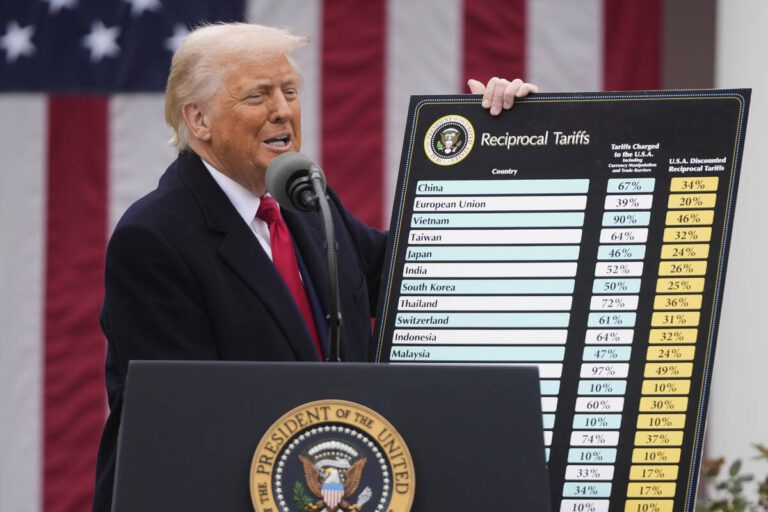Trump Unveils Sweeping Tariffs on Imports, Shaking Global Trade Framework
On Wednesday, President Donald Trump introduced a groundbreaking trade policy, establishing a 10% baseline tax on imports from all nations and imposing elevated tariff rates on various countries. This unexpected move threatens to alter the foundational aspects of the global economy and potentially ignite widespread trade conflicts.
Details of the Tariff Proposal
During a press conference at the White House, Trump displayed a chart outlining the proposed tariffs, which include:
- 34% on imports from China
- 20% on imports from the European Union
- 25% on imports from South Korea
- 24% on imports from Japan
- 32% on imports from Taiwan
Economic Justifications
Trump characterized the current trade system as exploitative, stating, “our country has been looted, pillaged, raped, plundered” by others. By declaring a national economic emergency, he aims to reshape America’s trading relationships, projecting that the tariffs could generate hundreds of billions in annual revenue. He argues that this initiative would result in the resurgence of manufacturing jobs in the U.S. However, these tariffs may also lead to a quick economic downturn, with consumers facing significant price increases across various goods including automobiles and clothing.
Implementation Strategy
The tariffs are designed to target countries that export more to the U.S. than they import, addressing an estimated $1.2 trillion trade deficit from the previous year. By using the 1977 International Emergency Powers Act, Trump is executing this trade strategy without congressional approval, marking a significant move in U.S. trade policy.
Concerns and Commentary
Despite signs of potential economic trouble, including declining consumer sentiment and warnings from economists about rising costs and stagnation, the administration remains committed to its strategy. Senior officials emphasize that the planned taxes are essential for ensuring compliance and are measuring tariffs based on existing trade deficits.
Critics across the political spectrum have voiced concerns regarding the unilateral nature of these tariffs, labeling them a tax increase on American families devoid of legislative approval. Representative Suzan DelBene commented, “This is a massive tax increase on American families, and it’s without a vote in Congress.”
International Reactions
As expected, long-term allies are formulating responses. Canada has already imposed tariffs in reaction to earlier U.S. measures tied to the fentanyl crisis. Meanwhile, the European Union has responded to steel and aluminum tariffs with its own levies on American goods worth approximately 26 billion euros. Ursula von der Leyen, President of the European Commission, remarked, “If it is necessary, we have a strong plan to retaliate and we will use it.”
Additionally, Italy’s Prime Minister, Giorgia Meloni, expressed the need to avoid a U.S.-EU trade war, highlighting the negative economic impacts it could have on both sides.
Conclusion
The announcement of these tariffs introduces a new layer of uncertainty in the global economy, potentially leading to repercussions that extend far beyond U.S. borders. As business leaders grapple with the unpredictability of upcoming tariffs, it remains to be seen how these policies will ultimately shape both national and international economic landscapes.
For further updates on this developing story, stay tuned.


